There are many factors that influence how big adult bearded dragons get.
Their full grown size is determined by genetics, sex, environment, diet and health.
Healthy babies grow at a rate of 1 to 3″ per month.
An adult will be fully grown at 12 months of age. Bearded Dragons should measure anywhere from 16 to 24 inches in length and weigh 380 to 510 grams.
Most of their size comes from their tail. Their tail is at least the same length as their body – if not longer.
Forecasting the adult size of your baby dragon can be difficult. But, you can use a juvenile’s growth rate to get an accurate guesstimate (more on this later).
So let’s take a closer look at how big do bearded dragons get and how to accurately guesstimate their size whilst still juveniles…
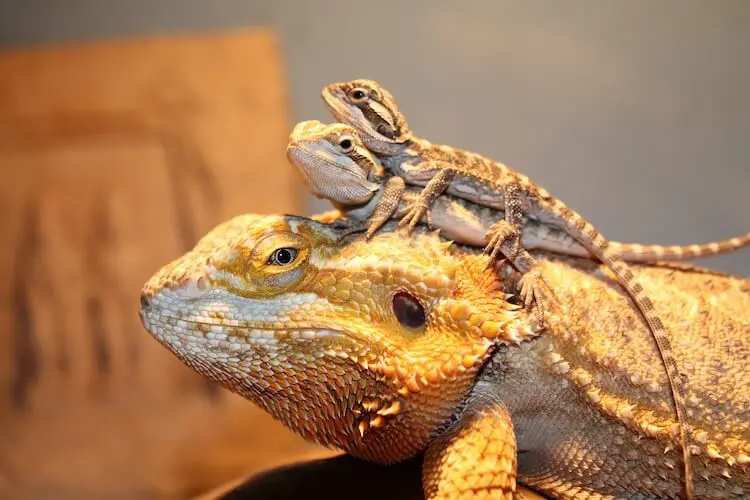
How Big Do Bearded Dragons Get?
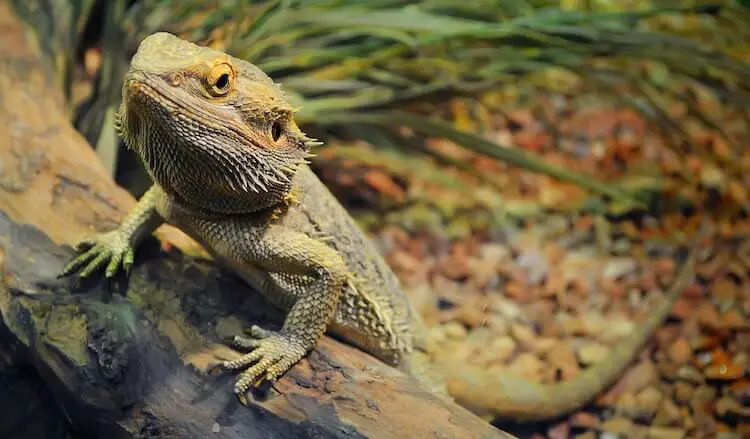
A bearded dragon full size is 16 to 24 inches in length and 380 to 510 grams in weight.
Bearded dragons reach their full size after reaching sexual maturity. The exact time of sexual maturity changes for each lizard but most fall between 8 to 18 months.
After one year your Beardie’s growth rate will slow significantly. At this age a healthy adult will have a filled-out belly and thick tail base.
If it grows larger than 24 inches then it is probably an uncommon morph known as the German Giant. German giants can grow to be 32 inches long and 1,000 grams.
A Beardie is considered unhealthy if they are under 16 inches in size or weigh less than 300 grams after 12 months.
If your pet is over 12 months old and still hasn’t reached the minimum size above it is likely they have suffered from stunted growth. Stunted growth can be caused by many factors and affects their physical or cognitive development.
Juvenile Bearded Dragon Size
A juvenile is aged 2 to 7 months. Over the course of these five months they will grow from 8 grams to 280!
Juveniles grow 1 – 3” per month.
During this age it is crucial they get proper nutrition.
You need to make sure your pet is given enough space and is separated into individual 30-gallon cages. They begin to have territorial tendencies and vary enough in size to become dominant. Larger dragons may dominate the food bowl, good basking areas and hideouts.
This can leave smaller or more submissive dragons without enough nutrition or adequate lighting.
Baby Bearded Dragon Size
Hatchlings are born just 4 grams and 3 inches in size.
During their first two months hatchlings can grow at 1 – 1.5″ per week! They will also gain 5 to 35 grams over the first two months.
You will need to weigh babies weekly to make sure they are within the normal growth rate.
If you are concerned your hatchling is not growing fast enough then observe their feeding habits and check their lighting.
They may not be eating enough because of competition between other hatchlings or because they are ill with an impaction or metabolic bone disease.
Correct lighting, nutrition and bedding are vital during their first year:
- Baby bearded dragons need high ratios of protein. They should be fed more insects than salads.
- They should also have a basking bulb on the outside of the lid’s mesh at least six inches from the highest basking spot and an T5 UVB tube light.
Their environment is key to their growth and survival.
Bearded Dragon Sizes by Breed
There are eight subspecies of Bearded Dragon.
Each subspecies originates from different regions of Australia. They are sized differently to adapt to those specific regions:
| Bearded Dragon Subspecies | Size (inches) | Weight (grams) |
|---|---|---|
| Pogona microlepidota | 4 – 6 | 6 – 40 |
| Pogona henrylawsoni | 9 – 12 | 50 – 200 |
| Pogona minor mina | 10 – 12 | 100 – 200 |
| Pogona nullarbor | 12 – 14 | 200 – 250 |
| Pogona minor | 14 – 18 | 250 – 450 |
| Pogona minor mitchelli | 16 – 18 | 380 – 450 |
| Pogona vitticeps | 16 – 24 | 380 – 510 |
| Pogona barbata | 20 – 24 | 400 – 510 |
Bearded Dragon Growth Rate
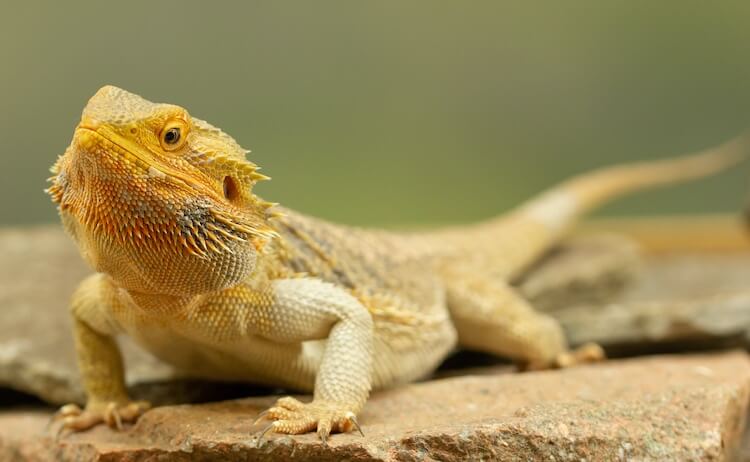
Baby bearded dragons have an extremely accelerated growth phase. Their size will increase quickly from three to eleven inches within their first three months of age.
You should expect them to grow two inches per month and gain 10 to 50 grams each month.
After three months of age they will grow at a slightly slower rate.
Juveniles grow 1 to 1.5″ per month and gain 50 grams per month.
During their rapid growth phase they shed once or twice a month. After a year their size growth rate slows to a stop and they will shed just once or twice a year.
After one year your Bearded dragon will weigh around 350 grams and will gradually bulk up over the next 12 months.
How Big Will My Bearded Dragon Be?
It may seem impossible to predict how big your bearded dragon will be, especially considering growth facts such as environment, diet and health. However by using a growth chart a fairly accurate guesstimate can be made.
You will need to start by observing the growth rate of your juvenile for their first six months.
At six months of age if they are 15 inches or more you can expect your dragon to be on the larger side. It is likely you have a very large dragon that will grow to 22 inches in size.
The opposite is also true.
A Beardie at six months that is 11 inches in size will most likely be between 16 to 18 inches as an adult.
Normally Bearded Dragons stop growing after they reach sexual maturity at 8 – 18 months.
The size of your dragon at 12 – 18 months will be its final size. They may grow slightly over the rest of their life – but it would be very minimal:
Bearded Dragon Growth Chart
| Age (months) | Size (inches) | Weight (grams) |
|---|---|---|
| 1 | 3 – 4 | 4 – 6 |
| 2 | 5 – 9 | 8 – 40 |
| 3 | 8 – 11 | 22 – 110 |
| 4 | 9 – 12 | 41 – 115 |
| 5 | 11 – 16 | 102 – 115 |
| 6 | 11 – 18 | 183 – 188 |
| 7 | 13 – 18 | 230 – 280 |
| 8 | 14 – 20 | 252 – 327 |
| 9 – 10 | 16 – 22 | 280 – 360 |
| 11 – 12 | 16 – 24 | 350 – 465 |
| 12+ | 380 – 510 |
Factors That Influence A Bearded Dragon’s Size
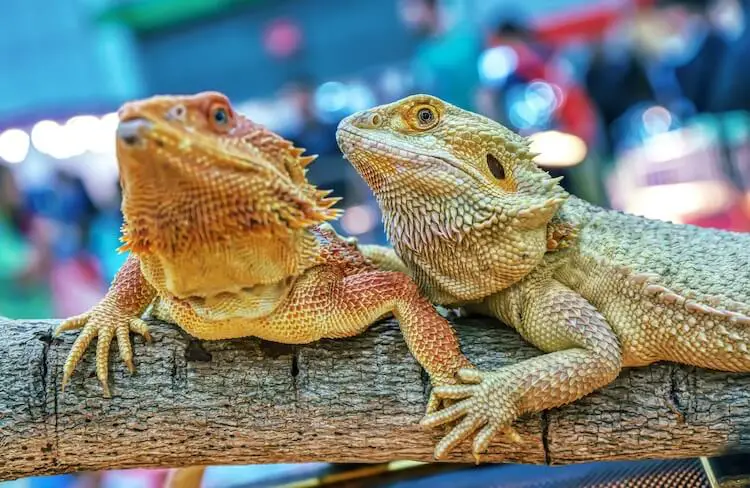
When you first hold your tiny dragon you can’t help immediately starting to guess how many times its current size it will grow to be.
You would be right in imagining a doubling, tripling or quadrupling in size.
Expect their growth to be quite extreme.
Babies and juveniles grow very quickly during their first year of life, but what factors influence how fast they grow?
1. Genetics
Genetics plays a large role in the maximum size your dragon can be.
These determinants are inherited from how large their parents are.
2. Gender
Gender also influences their size.
Bearded dragons are sexually dimorphic but this is subtler than most pet lizards.
Differences between males and females can be seen by their femoral pores, bumps on their tail’s ventral area and physical size.
Females are typically 16 to 19 inches in length. They are normally on the smaller end of the spectrum for length and head size.
3. Diet
In order to develop and grow properly a Bearded Dragon must be given a complete diet.
You should avoid feeding low-nutrient foods (e.g. iceberg lettuce) as it can stunt their growth.
Also avoid feeding high-fat insects with improperly balanced nutrients (e.g. grubs).
Finally, their diet should change with their age:
- Juveniles need more protein than adults. They should be fed 75% insects and 25% plant material (e.g. greens, vegetables and fruits).
- Adults should be fed a split of 75% greens, vegetables, and fruits and 25% insects.
4. Housing
A Bearded Dragon’s adult size can be affected by their environment. Specifically their housing.
You need to make sure there is enough room in their enclosure.
Improper tank size can lead to stunted growth as your dragon will not have enough space to grow or exercise.
Juvenile bearded dragons can live in a 40-gallon tank but adults need a 120-gallon enclosure.
You also need to make sure you have the correct lighting in their tank. In addition to the UVB light, you will need to feed a calcium supplement with vitamin D.
Faulty or incorrect lighting types can hinder or stunt growth. Without enough heat or UVA/B rays your lizard will not be able to efficiently absorb nutrients or synthesize vitamin D. This will compromise their metabolic function and can cause metabolic bone disease.
5. Husbandry
Poor health care or a general lack of husbandry will reduce the size and weight of your pet.
Illnesses such as impaction or parasites will prevent them from getting enough nutrients. These health issues will take a toll on your dragon’s physiological function and slow their growth.
If you see signs of weight loss, bloating, sluggish behavior or significant appetite changes then speak with your vet.
Bearded Dragon Weight
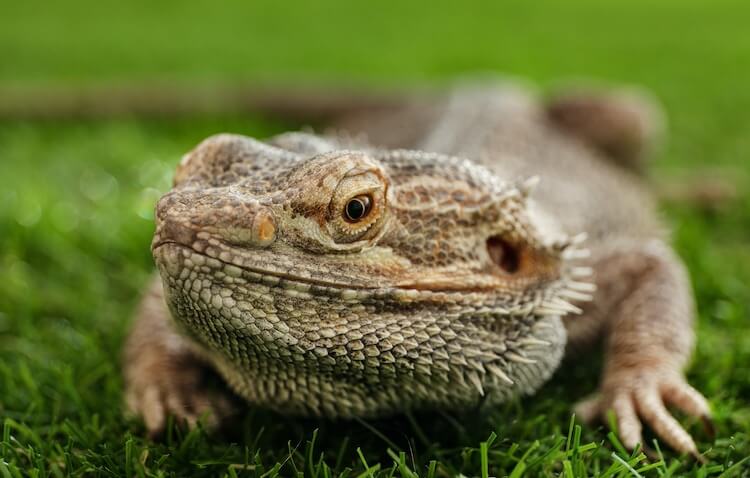
An adult’s bearded dragon size will measure anywhere from 16 to 24 inches and weigh 380 to 510 grams.
Any Bearded Dragon over 510 grams is considered obese.
When monitoring their weight you should make sure there is not sudden weight gain or loss. Changes in weight can be a sign of illness.
It is important to keep lizards a healthy weight. Excess fat can lead to prolapses and organ diseases.
How Can I Tell If My Bearded Dragon Is Overweight
Fat species will have a bulged belly that overextends beyond its sides when standing. They will also have very thick legs and a plump chest area.
If only the belly is enlarged (and your beardie is female) she may have egg retention and require surgery.
If your bearded dragon is overweight you should start by checking their tank temperature. If the basking spot is much greater than 95 to 100℉ they may be hungrier than they should be.
Many full grown adults become obese because of an overly affectionate owner who overfeeds them.
You can help your Beardie to lose weight by changing their diet:
- Increase the ration of greens to insects – adults only need insects three times a week.
- Select less fatty and more protein-heavy insects – avoid superworms and choose hornworms.
Finally, you can increase their exercise and enrichment:
- Try and make them exercise for their meals – put insects far away when feeding.
- Take them outside and use a play pen.
How Can I Tell If My Bearded Dragon Is Underweight
An underweight or skinny Beardie will have a flat body with wrinkled, loose skin. Their normal “fat pads” on the backs of their legs and skull will be sunken too.
You will be able to see their spine and ribs.
For baby bearded dragons you should track their weight gain to a growth chart.
If they are underweight follow the steps below:
- Observe their appetite. If they are eager to eat then get a fecal exam as they may have parasites.
- If their appetite is sluggish there might be an environmental issue (e.g. too cold) or you may have accidentally induced brumation. Bearded dragons go into brumation when there is a lack of sunlight or food.
- If they stop eating completely then they may be suffering from impaction. This is a common issue for pet lizards with incorrect substrate that blocks their digestive system.
If you have ruled out health and husbandry issues then you have a picky eater.
You may need to vary the diet you feed by changing their vegetables and insects.
Typically underweight Bearded Dragons are juveniles who have not hit their growth spurt or are adults with anorexia.
Summary
Now you know how big an adult bearded dragon will get. A healthy and well-nourished adult Bearded Dragon will be 16 to 24 inches in length and 380 to 510 grams in weight.
Hatchlings are born three inches long. They will grow two inches per month for their first three months.
Make sure you reference the growth chart in this article as your lizard grows.
If you notice any sizes outside of the normal ranges, then immediately review their lighting, diet, and tank-size. As long as they are within the stated size range, then you have a healthy reptile.
A healthy diet, correct environment and consistent husbandry will help your dragon reach their full grown size.
Let us know how much your bearded dragon weighs below.

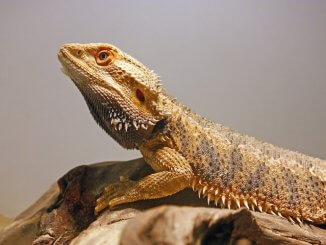
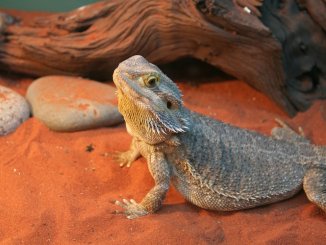
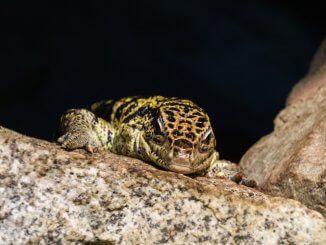

My dragon won’t eat veggie. What can I do to get him to eat?
Hi Amanda, how old is he?
try bee pollen! bee pollen is often considered “bearded dragon crack” sprinkle some pollen on the veggies you want them to eat and have patience. Some dragons may become picky with what they eat- some won’t eat anything but insects. I make sure to introduce new veggies every now and then to my beardie (A male Juvie) … so far he only reacted negatively to green beans…. he shook weirdly before spitting the piece of green bean out on the floor. I sometimes get organic baby food: veggies as a treat… also a way to introduce veggies, with an oral syringe he will lap it up after I put some on his nose.
We have a 5 month old with probable German Giant bloodlines. She’s 312g and 16 inches as of her measuring tonight! We are lucky to have a pretty adventurous eater, at least for now, in that although she has preferences, she’ll eat nearly anything we offer her. She’s our first dragon, but we have been very lucky to have one who is very easy going and easy to handle. She’s even allowed new people to hold her with minimal fuss.
My dragon is 22 inches long and weighs 700 grams, he’s only 3 years old. His tank is 4x2x2 but he has a good couple of hours free run throughout the house. He has no issue with climbing a flight of stairs and he loves to swim. He has about 10-15 large locusts a week and eats plenty of greens, fruit and vegetables. He seems very healthy and happy but I’m worried he’s too big for his age. His breeder thinks he’s great and said his parents are massive too. Should I do something for his weight?
I am having a problem with both my dragons weight too. They both turned a year old and one is 528 grams that is the female the male is 590 grams. Please help?
My bearded dragon is only 13in in length and is 10months old, is this normal ?
That’s very abnormal. Check his lights and diet. If temps are okay and he eats good it is possible you have a rankins dragon. They are smaller than bearded dragons but as babies are hard to tell apart. Their care requirements are the same. I have a rankins dragon my self. He’s. A year and is only 13 inches long and 300 grams and vet says he’s fine. Vet could help u confirm if he’s a rankins. There are a lot of articles on this on the web too. Hope this helps
Except the words ‘very abnormal’, I agree with everything suggested by Anna in response to Alan. Indeed, even other morphs of bearded dragon might be in the lower end of the size spectrum and have that size and that age. But do check the parameters of his enclosure and monitor his behavior to see whether he might show signs that he is not getting what he needs. Diet and temperature are very important when it comes to size outcomes.
I was given an adult male bearded dragon today. I would like to know how to tell which species he comes from. While driving home he kept his color a dark brown (he doesn’t like going places I presume), but after being in the house over an hour he changed his coloring to yellow.
The change in colour might have been caused by the stress of travelling and feeling threatened, sure. Alternatively, the dragon might have felt cold, so it tried to absorb as much sunlight as possible during that trip, by turning black. In the former case, they usually move and shape their bearded throat too.
As to the species, most bearded dragons in captivity are from the Pogona Vitticeps species. However the Pogona genus has another five species. You can easily search them, or directly search for an identification guide of the Pogona genus, and quickly determine its species.
Rae is 8.5 months 16” and 294g
Spike is 19 inches, weighs 460 g and is 2 years old
My bearded dragon is 2 years old and 17 inches should I be worried?
No, there is no reason to worry. Despite being in the lower end of the spectrum, your dragon falls within the normal size range. Genetic factors as well as diet-related factors in the first weeks and months determine adult size.
I’m going away for 10 days and am very nervous about leaving my dragon in the care of others. We’re guessing he’s around 8-9 months old (20″ or so). Curious if you have any advice as to how to simplify care instructions (feeding in particular) for my hired caregivers? Thank you!
Hi Carrie! That is totally understandable.
I have had this problem myself, and I found this to be the best solution: Show them! And perhaps even let them try in your presence. For someone who has never handled a lizard, this would be an invaluable experience, and it will give you the peace of mind of knowing your keepers have done this at least once before. Explain the different situations they might encounter, and the things to look out for.
I also used to print out our article on feeding a Bearded Dragon, maybe highlighting the parts that seem most relevant to your case, like the common feeding mistakes.